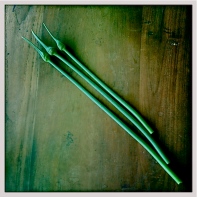I’ve been thrilled that we still have pears on the trees this year, and there’s quite a few of them. However, I have noticed something rather untoward, some black patches are forming on the fruit. This is not a good sign, it’s a strong indication that the tree is still plagued with a fungal micro-organisim called Venturia Pirina, or pear scab!
Last year we failed to harvest a single pear. The majority of the fruit fell from the tree during ‘June Drop’, with the exception of 5 pears…. and they all ended up looking like this
Poached pear anyone?!?!
There were also signs of pear rust on the leaves.
This tree was obviously in poor health and it was clear some drastic action was needed to nurse it back to health. We have an organic approach to gardening, so the question we asked ourselves is what can we do? We thought of two things initially
Good air circulation is vital to help prevent air-bourne diseases from spreading and multiplying. Mould and fungal spores thrive in a damp, closed environment. When we acquired the plot it was obvious the fruit trees hadn’t been pruned for some time. We therefore gave them a good summer prune, removing around 25% of the canopy including many of the inner lateral branches. This opened up the tree helping improve air circulation.
Also in the Spring I sprayed all the fruit trees with an organic seaweed fertiliser.. Seaweed fertiliser is full essential trace elements, some of which help improve the tree or plants defence against bacterial infections.
Whilst these actions helped to a degree it certainly hasn’t got rid of the problem so more research was required. Here are my findings.
Pear scab
Pear scab, Venturia Pirina, is a fungal disease caused by the transfer of spores. Infected trees initially develop dark blotches on the upper surface of leaves. These blotches form pockets of spores that multiply, eventually spreading the disease throughout the tree. Severely infected leaves can turn yellow and fall from the tree prematurely.
Spores that have spread to the underside of the leaves infect young developing fruit. Infected fruit develop black blotches on the upper part of the fruit. If you look at the earlier picture, you will see that the pear has become horribly cracked. The reason for this is these dark, roughened patches restrict the ability of the skin to expand. As the fruit grows in size these dark blotches on the skin are unable to grow at the same rate. This causes the fruit to either become mis-shapen, or in extreme cases, the skin eventually splits and large cracks appear.
This fungal disease is most active from mid spring onwards, with the spores thriving in damp, humid, closed in conditions. In severe cases, scab will reduce the vigour of a tree because it may lead to premature leaf fall.
To make matters worse the spores overwinter on the fallen leaves, on stems and branches. In the spring, if the leaves are left on the ground, the overwintered spores can be carried by the wind to newly emerged shoots and leaves. To prevent the risk of re-infection it’s a good practice to rake up the fallen leaves in the Autumn and burn them. Chemical sprays could be used to treat the actual tree stems and branches, but this isn’t an option for us. In the Spring, if blotches start to appear on leaves it’s best to remove the infected leaves immediately to help stem the spread of the disease.
Pear Rust, Gymnosporangium Libocedri
The initial signs of pear rust are usually visible in July and become more active in August and September. The leaves develop patches of bright orange discolouration, these eventually develop into spore-producing structures called pustules.
Rust will not kill the pear tree as the spores only survive on live tissue. However, the spores feed on the trees nutrients which will ultimately weaken the tree not only for this year but also for the following year.
Pear rust has an interesting life cycle. After feeding on a pear tree the spores transport themselves to a new ‘host’, usually a tree from the Juniper family. Here the pear rust spores will stay and feed for another year, before transporting back to another pear tree. This ensures a steady and plentiful supply of nutrition.
Spores are spread by either the wind or water so good air circulation is essential to help prevent the onset of fungal diseases. To prevent the spread of infection it’s best to carefully remove any infected leaves and burn them. Pear rust spores can remain air-bourne for some considerable distance (up to 6 km) so environments such as allotments will make it very hard to get rid of the problem completely, even if treated.
Very severe cases of rust can impact fruit yield, lead to premature defoliation and it can also cause perennial ‘canker’ like swellings on the branches…. YIKES! Oh goodness, I think we may have some of those on some of the branches! More research required….
Canker
Tree canker is caused by fungus spores entering the trees bark. Initial indications of canker are leafless branches, or branches with shrivelled and contorted leaves…. the bark may become darkened, cracked and rough, and lumps may appear with sticky substances oozing out!
It’s important to remove any canker from the tree as the disease will continue to spread deep into the wood eventually killing the tree. It also creates ‘openings’ in the trees bark making the tree susceptible to other fungal and bacterial infections. Canker will also impact the trees ability to produce a decent crop of fruit.
I’m going to do some more research on canker removal and will follow up with another post.
The good news is, my beloved Discovery apple tree is scab, rust and canker resistant. As if I needed another excuse to get one!




















Leave a comment